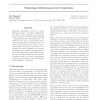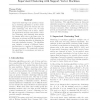ALT
2008
Springer
15 years 2 months ago
2008
Springer
In this paper, we initiate a theoretical study of the problem of clustering data under interactive feedback. We introduce a query-based model in which users can provide feedback to...
SDM
2009
SIAM
15 years 2 months ago
2009
SIAM
Given the pairwise affinity relations associated with a set of data items, the goal of a clustering algorithm is to automatically partition the data into a small number of homogen...
KDD
2004
ACM
15 years 5 months ago
2004
ACM
We propose and test an objective criterion for evaluation of clustering performance: How well does a clustering algorithm run on unlabeled data aid a classification algorithm? The...
ISBI
2008
IEEE
15 years 6 months ago
2008
IEEE
We propose a Bayesian approach to incorporate anatomical information in the clustering of fiber trajectories. An expectationmaximization (EM) algorithm is used to cluster the traj...
ICML
2000
IEEE
15 years 6 months ago
2000
IEEE
Clustering algorithms conduct a search through the space of possible organizations of a data set. In this paper, we propose two types of instance-level clustering constraints ? mu...
ICML
2005
IEEE
15 years 6 months ago
2005
IEEE
Supervised clustering is the problem of training a clustering algorithm to produce desirable clusterings: given sets of items and complete clusterings over these sets, we learn ho...
ICPR
2004
IEEE
15 years 6 months ago
2004
IEEE
We describe a clustering algorithm based on continuous Hidden Markov Models (HMM) to automatically classify both electrocardiogram (ECG) and intracranial pressure (ICP) beats base...
CVPR
2008
IEEE
15 years 7 months ago
2008
IEEE
We propose a variational bayes approach to the problem of robust estimation of gaussian mixtures from noisy input data. The proposed algorithm explicitly takes into account the un...


